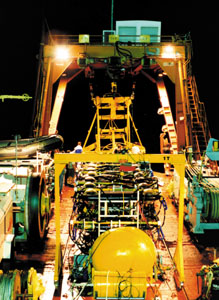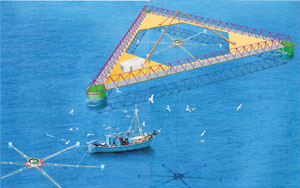For many years, physicists searching for and studying delicate physics effects have been working in the shelter of large underground installations. Now the ocean too is the scene of new physics developments.

Where do cosmic rays come from? What mechanisms can accelerate particles to ultrahigh energies? What happens around a supermassive black hole? What kind of phenomenon is responsible for the mysterious gamma ray bursts? Have dark matter particles gathered in the centre of the Earth or of the galaxy? These questions and many others now motivate ambitious experiments in high-energy astrophysics. Astronomy with high-energy neutrinos may soon be able to answer some of these questions and drastically change our point of view on the universe.
If one wants to understand the sources of high-energy cosmic rays, one faces a fundamental difficulty: at high energy the traditional messenger, the photon, is absorbed by the radiation and matter that it encounters along its path from the sources to the detectors – the universe is actually opaque to high-energy gamma rays. Primary cosmic rays are electrically charged so they are deflected by galactic and intergalactic magnetic fields, and it is hard to identify their sources. To look at the high-energy sky, one is thus forced to use another messenger that is electrically neutral and basically insensitive to obstacles. The neutrino is the ideal messenger.
Underwater observatories


However, because of these essential qualities, neutrinos are also difficult to detect: one needs a big target to catch them – bigger than the already huge existing underground detectors. One also needs efficient shielding against background due to penetrating cosmic rays. The adopted solution is to equip large volumes of a natural medium that is transparent to visible light with an array of photodetectors. These electronic eyes can then detect the wake of Cerenkov light emitted by the charged particles induced by neutrino interactions in or near the detector. This almost 40-year-old idea has led to projects to construct cosmic neutrino observatories under the sea.
One of these – the ANTARES project, a deep-sea neutrino telescope in the Mediterranean Sea – is expected to play a pioneering role in this new area of astronomy. (The original Antares is the star Alpha Scorpii, the brightest star in Scorpio and so named because it was believed to be an opponent of Mars/Ares.)
The DUMAND project to mount a major detector in the Pacific near Hawaii, long a feature of physics conferences, was unfortunately abandoned. However, the baton has also been taken up by the AMANDA and RICE projects in the Antarctic ice, the RAND Antarctic scheme, the Lake Baikal detector in Siberia and the Greek-led NESTOR project.

The Italian NEMO project is evaluating deep-sea sites and carrying out environmental studies off the coasts of Italy and Sicily.
Since 1996 the physicists and engineers of the ANTARES project have assessed the feasibility of a deep-sea telescope. Three years of intense R&D went into understanding the deep-sea environment and solving the technical challenge of deploying a complex and large piece of equipment in the Mediterranean Sea. The collaboration has now begun the construction of a 300 m2detector off the French Mediterranean shore.
ANTARES is now a CERN “Recognized experiment”. The collaboration consists of 16 particle physics institutes, 2 marine science institutes and an astronomy institute from France, Italy, the Netherlands, Russia, Spain and the UK.
Neutrinos as cosmic messengers
Until now, apart from a handful of events induced by a nearby supernova in 1987, no neutrino of cosmic origin has been identified. High-energy source candidates like cores or jets of active galactic nuclei, or the extremely violent cosmic events that are thought to be responsible for frequent gamma-ray bursts, are increasingly being observed and becoming better understood, but their activity at high energy remains mysterious: do they produce high-energy cosmic rays or are they simply gamma-ray emitters?
If high-energy protons are accelerated in these sources, they must also emit neutrinos. On the other hand, if these high-energy cosmic accelerators cannot fulfil the role of producing the observed cosmic-ray spectrum, then very-high-energy cosmic rays (and neutrinos) must be created by non-accelerating mechanisms like the decay of Big Bang massive relic particles.
Furthermore, neutrinos could reveal the presence of dark matter in the form of neutralinos, the lightest of the yet undiscovered particles predicted by supersymmetry theories. These would have been formed in the early universe and would accumulate in the cores of stars, galaxies and planets, from where they would “shine” as neutrinos.
Last but not least, as recent history has shown, astrophysics experiments permit the exploration of domains beyond the reach of accelerator experiments: studying the fluxes of atmospheric neutrinos, the Super-Kamiokande and MACRO experiments have been able to test very small values of the mass difference between two types of neutrinos. The observation of the same phenomenon is also possible with large neutrino telescopes using the Earth’s diameter as a baseline and at higher energy, thus with very different systematics. It would thus be possible to confirm or rule out the recent evidence for neutrino masses and to measure neutrino oscillation parameters.
Neutrinos can only be detectable through their interaction with matter. As they interact very weakly, massive targets are necessary. High-energy muons produced via such interactions are electrically charged and very penetrating, with a trajectory that is almost aligned with that of the parent neutrino.
When they traverse a transparent medium such as seawater, these relativistic particles produce a wake of Cerenkov light. The time development of this luminous wake allows physicists to reconstruct the direction of the muon, and thus that of the neutrino, with a precision better than a fraction of a degree, and thus pointing back to the celestial object that emitted the neutrino.
High-energy cosmic rays that bombard the upper atmosphere generate a flux of high-energy muons, which constitute a significant background to other terrestrial measurements, even under several thousand metres of water. Only neutrinos are capable of traversing the Earth, and a chance interaction immediately afterwards produces an upgoing muon beneath the detector. The atmospheric muon background is removed by selecting only these upgoing tracks. Thus the Earth itself is used as a neutrino target as well as providing a shield to filter background muons. The detectors will therefore be looking towards the bottom of the sea.
A cosmic neutrino telescope will consist of a three-dimensional array of light sensors (photomultipliers) covering an effective volume of the order of a cubic kilometre at a depth of a few thousand metres. In a first stage, a smaller telescope will give the first indications of cosmic neutrino sources and fluxes and will be used to validate the methods of this new type of astronomy.
An initial requirement is to explore the unusual environment and study the design and deployment of a large deep-sea detector. A three-year step-by-step R&D programme was initiated in 1996 to measure the deep seawater properties and find a suitable site.
Another goal was to bring together and master the marine technologies required to deploy, connect and operate large and complex pieces of offshore apparatus in a deep-sea environment. In parallel, studies were carried out to optimize detector performance.
Autonomous instrumented mooring lines were used to study the properties of the seawater – transparency and light scattering, optical background due to natural radioactivity and living organisms, and the bio-fouling of optical surfaces. The results were very encouraging – light can travel over more than 50 m without noticeable alteration. In particular, the small amount of large-angle scattering promises good angular accuracy.
Deep-sea tests

To study mechanical solutions and to test deployment and recovery procedures, an actual size detector line has been built and was immersed and recovered several times during 1998. This line was 350 m high and consisted of 32 optical modules (glass spheres designed to protect the photomultipliers against water pressure). It was also instrumented with acoustic and electronic sensors to measure position to within 10 cm.
In a second stage the line was equipped with eight photomultipliers and deployed at a depth of 1100 m off Marseille in November 1999. It was linked to the shore by a 37 km submarine electro-optical cable. Atmospheric muon data analysis is under way. About one muon every 10 s is recorded and reconstructed. Position monitor analysis indicates an accuracy of a few centimetres on the reconstructed position of individual photomultipliers.
The future telescope will need to connect individual lines to a central node in situ.Deep-sea connection tests have therefore been carried out using the Nautile, a deep-sea submarine belonging to IFREMER. Connections were successfully made and electrically validated at a depth of 2400 m in December 1998.
With site quality and technical feasibility established, the project is entering a new phase. In three years a detector will be installed consisting of 1000 photodetectors on 13 lines, 400 m high and distributed over a 150 m radius surface. It will be deployed at a depth of 2400 m off Toulon and should provide an effective surface after reconstruction of 0.1 km2for 10 TeV muons, 0.2° angular resolution for muons above 10 TeV, and enable reconstruction of the direction and the energy of neutrino-induced muons over a wide range.
This detector will open a new era of cosmic neutrino astronomy and will also provide practical experience and expertise which will be invaluable for the realization of a future large-scale detector capable of conducting a search for astronomical sources.








